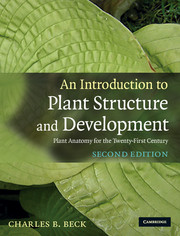Book contents
- Frontmatter
- Contents
- Preface to the second edition
- Preface
- Acknowledgements
- General references
- Chapter 1 Problems of adaptation to a terrestrial environment
- Chapter 2 An overview of plant structure and development
- Chapter 3 The protoplast of the eukaryotic cell
- Chapter 4 Structure and development of the cell wall
- Chapter 5 Meristems of the shoot and their role in plant growth and development
- Chapter 6 Morphology and development of the primary vascular system of the stem
- Chapter 7 Sympodial systems and patterns of nodal anatomy
- Chapter 8 The epidermis
- Chapter 9 The origin of secondary tissue systems and the effect of their formation on the primary body in seed plants
- Chapter 10 The vascular cambium: structure and function
- Chapter 11 Secondary xylem
- Chapter 12 The phloem
- Chapter 13 Periderm, rhytidome, and the nature of bark
- Chapter 14 Unusual features of structure and development in stems and roots
- Chapter 15 Secretion in plants
- Chapter 16 The root
- Chapter 17 The leaf
- Chapter 18 Reproduction and the origin of the sporophyte
- Glossary
- Index
- References
Chapter 4 - Structure and development of the cell wall
Published online by Cambridge University Press: 05 June 2012
- Frontmatter
- Contents
- Preface to the second edition
- Preface
- Acknowledgements
- General references
- Chapter 1 Problems of adaptation to a terrestrial environment
- Chapter 2 An overview of plant structure and development
- Chapter 3 The protoplast of the eukaryotic cell
- Chapter 4 Structure and development of the cell wall
- Chapter 5 Meristems of the shoot and their role in plant growth and development
- Chapter 6 Morphology and development of the primary vascular system of the stem
- Chapter 7 Sympodial systems and patterns of nodal anatomy
- Chapter 8 The epidermis
- Chapter 9 The origin of secondary tissue systems and the effect of their formation on the primary body in seed plants
- Chapter 10 The vascular cambium: structure and function
- Chapter 11 Secondary xylem
- Chapter 12 The phloem
- Chapter 13 Periderm, rhytidome, and the nature of bark
- Chapter 14 Unusual features of structure and development in stems and roots
- Chapter 15 Secretion in plants
- Chapter 16 The root
- Chapter 17 The leaf
- Chapter 18 Reproduction and the origin of the sporophyte
- Glossary
- Index
- References
Summary
Perspective
Nearly all plant cells are characterized by an enclosing, cellulosic wall. Those that are not, such as gametes, are either very short-lived or are protected by enclosure within a sheath or tissue of walled cells. Cell walls were first observed, in cork, by Robert Hooke in 1663 and considered to be “dead” structures. Furthermore, the cell wall, produced by and to the exterior of the protoplast, has been considered by some biologists to be an extracellular structure. Most botanists, however, have persisted in considering the wall to be the outer part of the cell, a view based largely on the integration of cytokinesis and cell wall formation. Strong justification for this viewpoint has been provided by research during the past several decades which has shown that the wall is a dynamic structure that receives biochemical information from the protoplast and sends information to it. Recent studies suggest that the wall is an integral component of a cell wall–plasma membrane–cytoskeleton continuum which provides a pathway for molecular and mechanical signals between cells in a tissue, or between cells and the external environment (Wyatt and Carpita, 1993; Reuzeau and Pont-Lezica, 1995; see also Wojtaszek, 2000). Major components of this continuum are plasmodesmata, highly specialized strands of endoplasmic reticulum which traverse the walls and connect the protoplasts of adjacent cells, microtubules, thought to play important roles in determining the orientation of cellulose microfibrils in the cell wall (Baskin, 2001), and actin microfilaments which have been implicated in cytoplasmic streaming and in the transport of vesicles containing precursor compounds to the sites of wall synthesis (Chaffey et al., 2000).
Information
- Type
- Chapter
- Information
- An Introduction to Plant Structure and DevelopmentPlant Anatomy for the Twenty-First Century, pp. 58 - 82Publisher: Cambridge University PressPrint publication year: 2010
